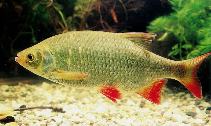| Family: |
Leuciscidae (Minnows), subfamily: Leuciscinae |
| Max. size: |
61.7 cm TL (female); max.weight: 3,623.0 g; max. reported age: 19 years |
| Environment: |
benthopelagic; freshwater; brackish; pH range: 7 - 7.5; dH range: 10 - 15; depth range - 0 m, potamodromous |
| Distribution: |
Eurasia: Most European rivers north of Pyrenees and Alps, eastward to Ural and Eya drainages, Aral and White Sea basins; Black Sea basin in Europe and northern Asia Minor. Naturally absent from Iberian Peninsula, Adriatic basin, Italy, Greece south of Pinios drainage, Great Britain north of 54 N, Ireland and Scandinavia north of 62° N (Ref. 59043). Definitely absent in Siberia. Reports from this area arose from the confusion between the rudd and the roach (Ref. 1441). Introduced to several countries. Several countries report adverse ecological impact after introduction (Ref. 1739). |
| Diagnosis: |
Dorsal spines (total): 3-3; Dorsal soft rays (total): 8-9; Anal spines: 3-3; Anal soft rays: 8-12; Vertebrae: 36-39. Distinguished from its congeners in Europe by the following combination of characters: 39-42 scales along lateral line; anal fin with 10-13½ branched rays; 9-12 gill rakers; dorsal head profile straight or slightly convex, snout pointing forward, tip at or slightly above level of middle of eye; back not humped behind nape; eye bit close to dorsal head profile when viewed laterally; articulation of lower jaw in front of anterior margin of eye; head and body compressed, head width 13-14% SL; head length 24-28% SL; caudal peduncle depth 1.5-2.0 times in its length, 11-12% SL; and all fins with reddish hue, pelvic fin deep red (Ref. 59043).
Caudal fin with 18-19 rays (Ref. 2196) |
| Biology: |
Occurs mainly in nutrient-rich, well vegetated lowland rivers, backwaters, oxbows, ponds and lakes. Feeds mainly on plankton, terrestrial insects and plant material. Breeds on roots or submerged plants. Can adapt to unfavorable environmental condition (Ref. 59043). Colorless or pale yellow eggs are found attached to vegetation in shallow water (Ref. 41678). Consumed fresh (Ref. 30578). Threatened due to the introduction of other species (Ref. 26100). |
| IUCN Red List Status: |
Least Concern (LC); Date assessed: 01 January 2008 Ref. (130435)
|
| Threat to humans: |
potential pest |
Source and more info: www.fishbase.org. For personal, classroom, and other internal use only. Not for publication.

